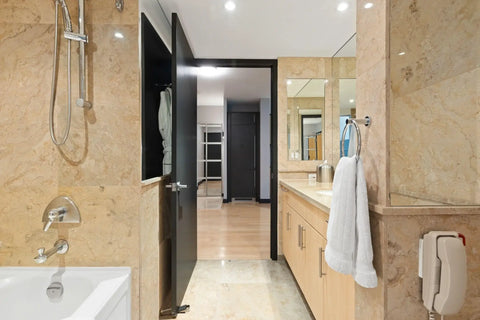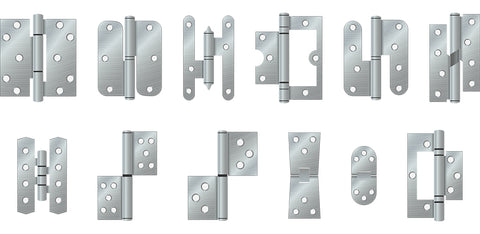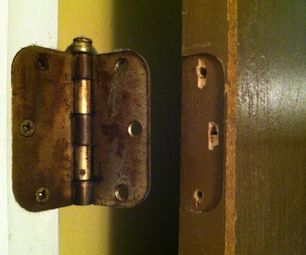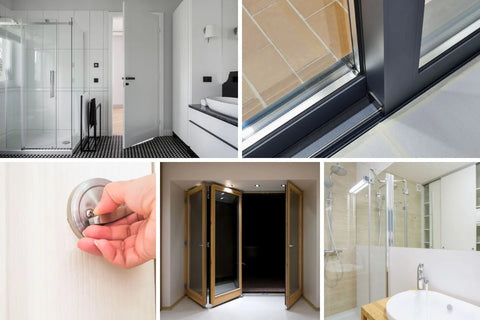
Exploring Bathroom Door Hinges: What You Need to Know
When it comes to home improvement projects, bathrooms often get overlooked despite being one of the most frequently used spaces in our homes. From the tiles on the floor to the color of the walls, every detail matters in creating a comfortable and functional bathroom environment. However, one aspect that is often underestimated but plays a crucial role in both functionality and aesthetics is the bathroom door hinge.
In this comprehensive guide, we'll delve into the world of bathroom door hinges, exploring their importance, different types, installation methods, maintenance tips, and more. Whether you're renovating your existing bathroom or building a new one from scratch, understanding the nuances of bathroom door hinges will help you make informed decisions and ensure that every aspect of your bathroom design is carefully considered.
Importance of Bathroom Door Hinges

Bathroom door hinges may seem like a minor detail, but they serve an essential purpose in ensuring smooth operation and longevity of your bathroom door. A properly installed hinge not only facilitates effortless opening and closing of the door but also contributes to the overall stability and security of the door structure.
Moreover, bathroom door hinges play a significant role in the aesthetics of your bathroom. They come in various finishes and styles, allowing you to complement the overall design theme of your bathroom. Whether you prefer a modern, minimalist look or a more traditional, ornate style, there's a hinge option to suit your preferences.
Types of Bathroom Door Hinges

There are several types of hinges available for bathroom doors, each with its own unique features and benefits. Some of the most common types include:
Butt Hinges: These are the most traditional type of hinges and are typically used for interior doors, including bathroom doors. Butt hinges consist of two rectangular metal plates joined together by a pin and are surface-mounted on the door and door jamb.
Concealed Hinges: As the name suggests, concealed hinges are hidden from view when the door is closed, giving a seamless and streamlined appearance to the door. These hinges are often used for modern, contemporary bathroom designs where a clean aesthetic is desired.
Pivot Hinges: Pivot hinges are designed to support heavy doors and are commonly used for shower doors or other large bathroom doors. They consist of a single pivot point that allows the door to swing open and closed.
Ball Bearing Hinges: Ball bearing hinges are known for their smooth and quiet operation, thanks to the ball bearings integrated into the hinge mechanism. They are a popular choice for high-traffic areas such as bathrooms, where durability and performance are essential.
Spring Hinges: Spring hinges are equipped with a spring mechanism that automatically closes the door after it has been opened. These hinges are ideal for bathrooms where privacy is a priority, as they ensure that the door always remains closed when not in use.
Installation of Bathroom Door Hinges

Proper installation of bathroom door hinges is crucial for ensuring smooth operation and longevity. Here's a step-by-step guide to installing butt hinges, which are the most common type of hinges used for bathroom doors:
Prepare the Door and Jamb: Begin by marking the locations for the hinges on both the door and the door jamb. Use a chisel to recess the areas where the hinges will be installed, ensuring that they sit flush with the surface.
Attach the Hinges to the Door: Secure the hinges to the edge of the door using screws, making sure they are aligned properly with the recessed areas.
Attach the Hinges to the Jamb: Next, align the hinges on the door with the corresponding recessed areas on the door jamb and secure them in place using screws.
Test the Door: Once the hinges are securely installed, test the door to ensure that it swings open and closed smoothly without any friction or resistance.
Install the Door Knob and Hardware: Finally, install the door knob, latch, and any other hardware according to the manufacturer's instructions, making sure everything is properly aligned and functioning correctly.
Maintenance Tips for Bathroom Door Hinges

To ensure that your bathroom door hinges continue to function smoothly and efficiently, it's essential to perform regular maintenance. Here are some tips to keep your hinges in top condition:
Lubricate Regularly: Apply a small amount of lubricant to the hinge pins and moving parts of the hinges to reduce friction and prevent squeaking.
Check for Loose Screws: Periodically inspect the screws holding the hinges in place and tighten any that have become loose over time.
Clean the Hinges: Remove any dust, dirt, or debris from the hinges using a soft brush or cloth to prevent buildup that could impede the movement of the door.
Inspect for Damage: Check the hinges for any signs of wear or damage, such as rust or corrosion, and replace them if necessary to prevent further issues.
Adjust Alignment if Needed: If the door begins to sag or no longer closes properly, adjust the hinges to realign the door and restore smooth operation.
By following these maintenance tips, you can prolong the lifespan of your bathroom door hinges and ensure that your bathroom door continues to function properly for years to come.
Choosing the Right Bathroom Door Hinges
Choosing the right bathroom door hinges may not seem like the most exciting part of designing or renovating your bathroom, but it's an important decision that can greatly impact both the functionality and aesthetics of the space. With a wide variety of hinge options available on the market, it's essential to consider factors such as door type, style preferences, durability, and maintenance requirements. Now, we'll walk you through the key considerations to help you select the perfect hinges for your bathroom door.

1. Door Type
The type of door you have will influence the type of hinges you need. Common door types for bathrooms include:
Standard Swing Door: Most bathrooms have standard swing doors that open and close on hinges attached to the door frame and door edge.
Pocket Door: In some bathrooms, space constraints or design preferences may lead to the use of pocket doors that slide into the wall cavity when opened. Pocket doors require special pocket door hardware rather than traditional hinges.
Shower Door: If your bathroom includes a shower enclosure, you'll need hinges specifically designed for glass shower doors. These hinges are typically made of corrosion-resistant materials and provide the necessary support for heavy glass panels.
Consider the type of door you have and ensure that the hinges you choose are compatible with its design and construction.
2. Style and Finish
Bathroom door hinges come in a variety of styles and finishes to complement different interior design themes. Some popular finishes include:
Chrome: Sleek and modern, chrome finishes are versatile and can work well with a wide range of bathroom decor styles.
Brushed Nickel: This finish offers a warmer, more subdued look than chrome and is a popular choice for transitional or contemporary bathrooms.
Oil-Rubbed Bronze: For a more traditional or rustic aesthetic, oil-rubbed bronze finishes add warmth and character to bathroom doors.
Black: Black finishes are trendy and can make a bold statement in modern or industrial-style bathrooms.
Consider the overall design theme of your bathroom and choose hinges that coordinate with other hardware finishes such as faucets, shower heads, and towel bars for a cohesive look.
3. Durability and Performance
Durability is paramount when selecting bathroom door hinges, as they are subjected to frequent use and exposure to moisture. Look for hinges made from corrosion-resistant materials such as stainless steel or solid brass, which can withstand the humid environment of bathrooms without rusting or deteriorating over time.
Additionally, consider the weight and size of your bathroom door when choosing hinges. Heavy or oversized doors may require heavy-duty hinges with ball bearing mechanisms for smooth operation and enhanced weight-bearing capacity.
4. Functionality
Beyond aesthetics and durability, it's essential to consider the functionality of the hinges. Some key factors to keep in mind include:
Smooth Operation: Choose hinges with smooth, frictionless movement to ensure that your bathroom door opens and closes effortlessly.
Noise Reduction: Opt for hinges with built-in features such as soft-close mechanisms or ball bearings to minimize noise and prevent slamming.
Adjustability: Select hinges that offer adjustability to compensate for any misalignment or sagging over time, ensuring that your door remains properly aligned and functional.
5. Maintenance Requirements
Finally, consider the maintenance requirements of the hinges. Choose finishes and materials that are easy to clean and maintain, as bathroom environments can be prone to moisture, dirt, and soap residue buildup. Regularly wiping down the hinges with a damp cloth and mild detergent can help prevent corrosion and keep them looking their best for years to come.
Conclusion
In this comprehensive exploration of bathroom door hinges, we've uncovered their crucial role in both functionality and aesthetics within our homes. From their importance in ensuring smooth operation and stability to their impact on the overall design theme of our bathrooms, hinges are a detail not to be overlooked. We've delved into the various types of hinges available, including butt hinges, concealed hinges, pivot hinges, ball bearing hinges, and spring hinges, each with its own unique features and benefits. Additionally, we've provided a step-by-step guide to properly installing and maintaining bathroom door hinges, emphasizing the importance of regular lubrication, inspection for damage, and alignment adjustments. Furthermore, we've highlighted key considerations for choosing the right hinges, such as door type, style and finish, durability, functionality, and maintenance requirements. By understanding these nuances, homeowners can make informed decisions to ensure that every aspect of their bathroom design is carefully considered, contributing to a comfortable and functional space.
